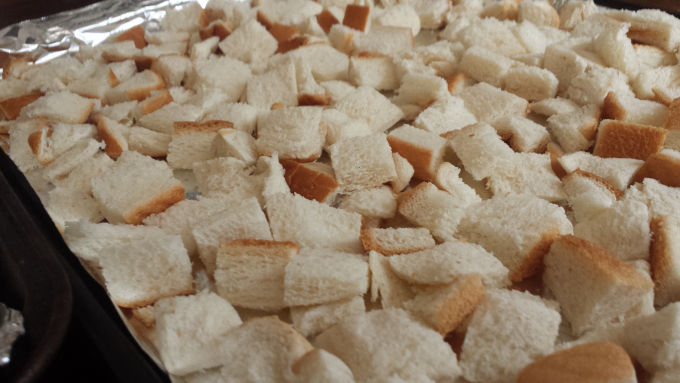
You can dry the bread out in the oven or let it sit out overnight. It doesn’t really matter.
Stuffing. That wonderful Thanksgiving staple we (well most of us anyway) all know and love. When that special day comes around, some dishes have become nothing short of mandatory. Turkey being the ultimate center piece that holds everything together around it. Sort of like a miniature solar system. I’m thinking Alpha Centurkey. It’s that epic.
But we’re not here to talk about just turkey. Some other honorable mentions in no particular order would be turkey gravy, mashed potatoes (smothered in turkey gravy), candied yams (yuck, gag.), rolls (smothered in turkey gravy), cranberries, and pumpkin pie (smothered in turkey gravy). Wait no, scratch that, pumpkin pie needs to be smothered with whip cream. That’s what I meant to say.
Sadly though, it has recently come to my attention about thirteen years ago, that some people had veered from this accepted tradition and strayed from the path. That’s right, the loyal and lovable turkey had been replaced by none other than a tiny little creature known as a Cornish game hen. If you’re reading this, you know who you are. I won’t name any names, but you know who you are.
Here’s the funny part about all of this, for as much of a staple Thanksgiving dish that stuffing is, no two families seem to be able to agree on the proper way to make or prepare it. Unless of course a boxed stuffing is going to be used. But let’s be honest, who can really say what the “proper” way of making stuffing is.
The point is, none of the other typical Thanksgiving dishes seem to have quite the number of variations as stuffing/dressing/filling. There are recipes that call for walnuts, pecans, apples, bacon, carrots, cranberries, and even raisins. In fact, I like to add water chestnuts to my stuffing, because it adds a nice little crunch.
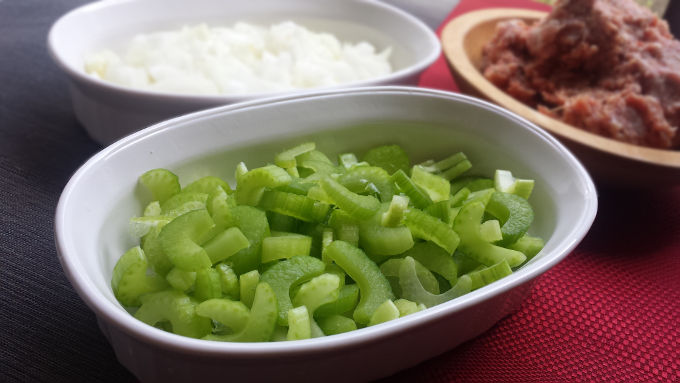
This popular dish is even called by different names depending on where you are in the country. The correct term is “stuffing,” because that’s what Northerners call it, and I’m from the North. If you’re from the South, you’ll probably be inclined to call it “dressing,” and that’s okay. What’s more, and I have never heard this term until recently, but apparently there are some Pennsylvanians who really love some “filling” with their Thanksgiving turkey.
I’ve been to the South, not during any holidays, but I’ve been there nonetheless. I didn’t have any stuffing, but I did have some fried cornbread and it was alright. And speaking of cornbread, Southern cooks serving up “dressing” usually insist that it be cornbread-based. That was a nice segue right? You know the cornbread thing…nevermind.
Below you can find more cool information about stuffing and its humble beginnings. But mostly I just want everyone to think I’m smart by throwing all kinds of random facts out here. To the best of my knowledge, this is how it all went down. Skip it if you don’t care about history.
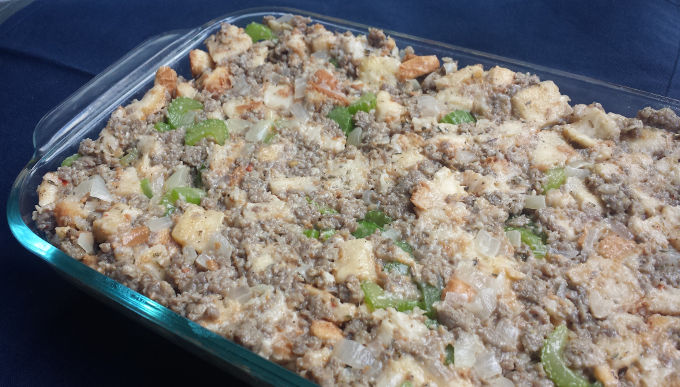
The recipe here fits perfectly in a 7″ by 11″ glass baking dish.
I guess during the 1850’s, the term “stuffing” was offensive to the Victorians, so the name was changed to “dressing.” At least that’s how I understand it. This was also the time that “dark meat” became popular when referring to the legs and thighs of the turkey. So the term “dressing” stuck. The dish made use of one of the staple foods at that time: cornbread.
Often times, pork was added either in the form of bacon or salt pork. But more often than not, as salt pork. Many Southern cooks at the time had a surplus of stale biscuits on hand as well, which led to a biscuit style “dressing” that has become standard in parts of the South.
One thing that most historians agree on though, is that given the ample amount of wild game and rice that was available to the Pilgrims, it’s highly likely that the first Thanksgiving dinner had some sort of bird as well as a wild rice dish. Chestnuts also became a popular addition to stuffing during those times. There were even “stuffing” varieties featuring mashed potatoes. These types are probably the least well known, and they contained mashed potatoes, stale bread, and lots of butter. They became dishes that could be served like a casserole beside the bird.
Later on to the west, cooks began experimenting with their own varieties of stuffing and came up with brand new recipes by combining the traditional Southern style with new ideas from the North. Cooks from San Francisco made good use of any leftover sourdough which added a nice tang to the meal. Other styles of stuffing particularly in the Pacific Northwest, began featuring seafood such as clams and oysters.
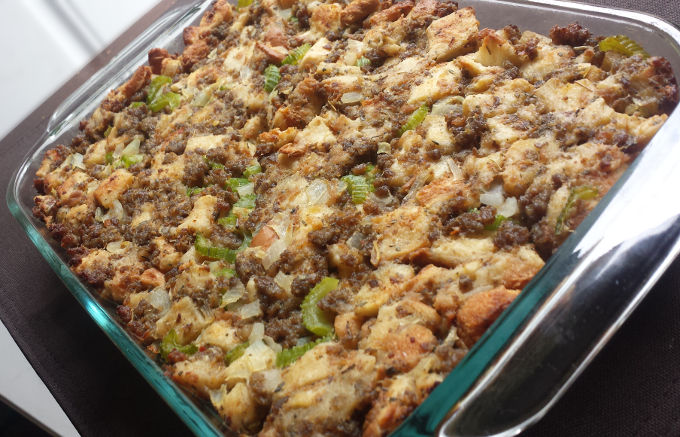
Here is the stuffing after it has been baked. If you stuff a turkey with it, the juices from the bird will keep the stuffing super moist.
You won’t find me touching any sort of stuffing that has seafood in it, but I’m sure it would be delicious for many other people. Breakfast sausage works just fine for me. And if you don’t want or don’t have the time to make everything from scratch, you can always just use your favorite boxed brand if you have one and beef it up. And by that, I don’t mean adding cow to your stuffing. I mean adding more ingredients. It’s much quicker that way and tastes just fine, although you won’t have the satisfaction of knowing that you made everything from the ground up.
The recipe below includes both breakfast sausage and water chestnuts, but they are definitely optional. If you want to make your stuffing lower fat, you might think about replacing the pork sausage with turkey sausage or even eliminate it all together.
The same goes for the water chestnuts; if they aren’t your thing, get rid of them. Make it how you like. Most importantly, let us know if the recipe is a win or if it doesn’t do it for you in the comments section below. And until next time, have a good one.
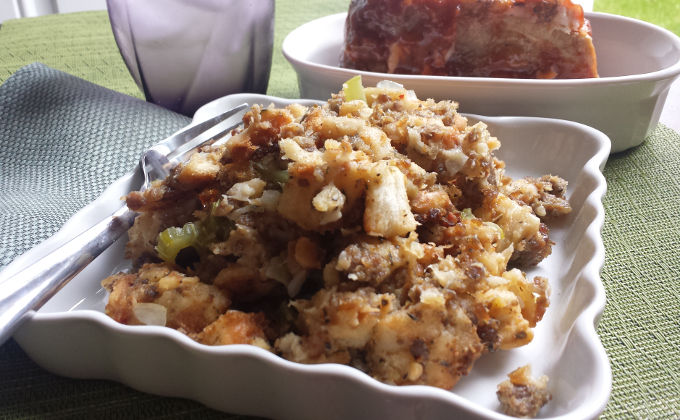
Delicious homemade stuffing ready to be devoured!
Sausage Stuffing
By: Semiserious Chefs
Serves: 8 – 10
Ingredients:
- Plain white bread (20 – 25 slices, or an average loaf)
- 1 lb breakfast sausage
- 1 cup onions (diced)
- 1 cup celery (diced)
- 2 tablespoons butter (unsalted)
- 2 teaspoons sage (dried)
- 1 teaspoon thyme (dried)
- 1 egg
- 1 3/4 cup chicken broth
- Salt and pepper (to taste)
- 1/2 cup chopped water chestnuts (optional)
Directions:
- Preheat oven to 225° F (110° C)
- Stack up 3 or 4 pieces of bread at a time and cut them into squares. If you aren’t sure how big to cut them, just shoot for something roughly the size of your thumbnail, or even smaller if you want. You’ll find what works best for you.
- Line 2 large sheet pans with aluminum foil and evenly spread the bread pieces out across them. Don’t over fill the pans, or it will cause some of the pieces of bread to not fully dry out. Lightly salt and pepper them.
- Allow the bread pieces to dry out in the oven for 50 – 55 minutes. Once done, remove from oven and allow to cool.
- While the bread is drying out in the oven, add the sausage to a medium sized frying pan and cook over medium heat for roughly 5 – 7 minutes or until fully browned. Drain any grease and set sausage aside.
- In another medium size pan, add butter and sauté onions, celery, and water chestnuts (if you are using them) over medium-high heat stirring occasionally for 4 – 5 minutes or until onions are just starting change color.
- Turn the oven up to 350° F (175° C)
- In a large bowl, add the previously cooked sausage, the sautéed vegetables, and the dried bread pieces.
- Now add the egg, sage, thyme, and chicken broth on top.
- Either use a strong spatula or your hands, and thoroughly mix the ingredients until they are very well combined.
- Pour the mixture into your baking dish (I use a 7″ x 11″ glass baking dish for this recipe) and cover with aluminum foil.
- Cook on center rack of 350° F (175° C) oven for 30 minutes.
- Remove foil and continue cooking for 20 – 30 minutes to crisp up the top layer. I let it continue cooking uncovered for 30 minutes, but if you want a little bit moister stuffing, cook uncovered for only 15 – 20 minutes.


Post a comment